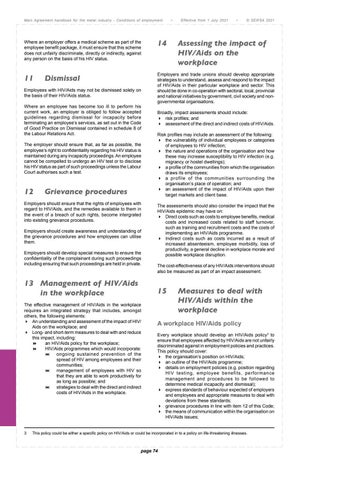Main Agreement handbook for the metal industry - Conditions of employment
•
Effective from 1 July 2021
•
© SEIFSA 2021
Where an employer offers a medical scheme as part of the employee benefit package, it must ensure that this scheme does not unfairly discriminate, directly or indirectly, against any person on the basis of his HIV status.
14 Assessing the impact of HIV/Aids on the workplace
11 Dismissal
Employers and trade unions should develop appropriate strategies to understand, assess and respond to the impact of HIV/Aids in their particular workplace and sector. This should be done in co-operation with sectoral, local, provincial and national initiatives by government, civil society and nongovernmental organisations.
Employees with HIV/Aids may not be dismissed solely on the basis of their HIV/Aids status. Where an employee has become too ill to perform his current work, an employer is obliged to follow accepted guidelines regarding dismissal for incapacity before terminating an employee’s services, as set out in the Code of Good Practice on Dismissal contained in schedule 8 of the Labour Relations Act. The employer should ensure that, as far as possible, the employee’s right to confidentiality regarding his HIV status is maintained during any incapacity proceedings. An employee cannot be compelled to undergo an HIV test or to disclose his HIV status as part of such proceedings unless the Labour Court authorises such a test.
12
Grievance procedures
Employers should ensure that the rights of employees with regard to HIV/Aids, and the remedies available to them in the event of a breach of such rights, become intergrated into existing grievance procedures. Employers should create awareness and understanding of the grievance procedures and how employees can utilise them. Employers should develop special measures to ensure the confidentiality of the complainant during such proceedings including ensuring that such proceedings are held in private.
13 Management of HIV/Aids in the workplace The effective management of HIV/Aids in the workplace requires an integrated strategy that includes, amongst others, the following elements: An understanding and assessment of the impact of HIV/ Aids on the workplace; and Long- and short-term measures to deal with and reduce this impact, including: an HIV/Aids policy for the workplace; HIV/Aids programmes which would incorporate: ongoing sustained prevention of the spread of HIV among employees and their communities; management of employees with HIV so that they are able to work productively for as long as possible; and strategies to deal with the direct and indirect costs of HIV/Aids in the workplace.
3
Broadly, impact assessments should include: risk profiles; and assessment of the direct and indirect costs of HIV/Aids. Risk profiles may include an assessment of the following: the vulnerability of individual employees or categories of employees to HIV infection; the nature and operations of the organisation and how these may increase susceptibility to HIV infection (e.g. migrancy or hostel dwellings); a profile of the communities from which the organisation draws its employees; a profile of the communities surrounding the organisation’s place of operation; and an assessment of the impact of HIV/Aids upon their target markets and client base. The assessments should also consider the impact that the HIV/Aids epidemic may have on: Direct costs such as costs to employee benefits, medical costs and increased costs related to staff turnover, such as training and recruitment costs and the costs of implementing an HIV/Aids programme. Indirect costs such as costs incurred as a result of increased absenteeism, employee morbidity, loss of productivity, a general decline in workplace morale and possible workplace disruption. The cost-effectiveness of any HIV/Aids interventions should also be measured as part of an impact assessment.
15 Measures to deal with HIV/Aids within the workplace A workplace HIV/Aids policy Every workplace should develop an HIV/Aids policy3 to ensure that employees affected by HIV/Aids are not unfairly discriminated against in employment policies and practices. This policy should cover: the organisation’s position on HIV/Aids; an outline of the HIV/Aids programme; details on employment policies (e.g. position regarding HIV testing, employee benefits, performance management and procedures to be followed to determine medical incapacity and dismissal); express standards of behaviour expected of employers and employees and appropriate measures to deal with deviations from these standards; grievance procedures in line with item 12 of this Code; the means of communication within the organisation on HIV/Aids issues;
This policy could be either a specific policy on HIV/Aids or could be incorporated in to a policy on life-threatening illnesses.
page 74



